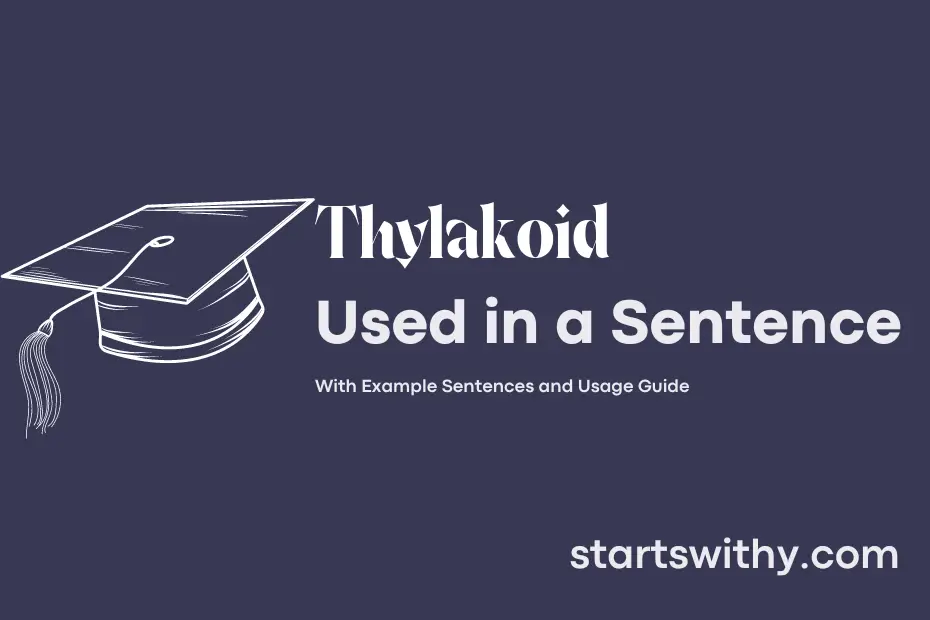Have you ever wondered where the magic of photosynthesis happens within a plant cell? Enter the fascinating world of thylakoids. Thylakoids are membrane-bound compartments found in the chloroplasts of plant cells where the light-dependent reactions of photosynthesis take place.
These disc-like structures are essential for capturing light energy and converting it into chemical energy, which is then used to power the plant’s processes. Without thylakoids, the crucial step of generating ATP and NADPH in photosynthesis would not be possible. Let’s dive deeper into the intricate role thylakoids play in the fundamental process that sustains life on Earth.
7 Examples Of Thylakoid Used In a Sentence For Kids
- Thylakoid is like a tiny room where plants make food.
- Plants use thylakoid to capture sunlight and make energy.
- Inside a plant cell, you can find many thylakoid.
- Photosynthesis happens in the thylakoid of a plant.
- Without thylakoid, plants wouldn’t be able to make their own food.
- Remember, plants need thylakoid to grow and stay healthy.
- Let’s learn more about how thylakoid helps plants make food!
14 Sentences with Thylakoid Examples
- Thylakoid is a membrane-bound compartment inside chloroplasts where photosynthesis takes place.
- The structure of a thylakoid is crucial for the light-dependent reactions of photosynthesis.
- To understand the process of photosynthesis, one must grasp the role of thylakoids in capturing light energy.
- Studying the arrangement of pigments within the thylakoid membrane can provide insights into energy transfer during photosynthesis.
- The ATP synthase enzyme plays a key role in the production of ATP within the thylakoid membrane.
- Understanding the function of electron transport chains in thylakoids is essential for grasping the mechanism of photosynthesis.
- The orientation of proteins within the thylakoid membrane is crucial for creating a proton gradient during photosynthesis.
- Students often conduct experiments to observe the movement of electrons through the thylakoid membrane in photosynthesis.
- The structure of thylakoids can vary in different plant species, impacting their photosynthetic efficiency.
- Grana, which are stacks of thylakoids, play a role in increasing the surface area available for light absorption in chloroplasts.
- The discovery of the role of thylakoids in photosynthesis revolutionized our understanding of how plants convert light energy into chemical energy.
- Effective note-taking during lectures on thylakoids can help students understand the complex processes involved in photosynthesis.
- Visual aids such as diagrams and animations can facilitate the comprehension of thylakoid function in photosynthesis.
- Knowledge of thylakoid structure and function is fundamental for students pursuing studies in plant biology and biochemistry.
How To Use Thylakoid in Sentences?
Thylakoid is a term used in biology to describe a membrane-bound compartment found within chloroplasts, where the process of photosynthesis takes place. To use “thylakoid” in a sentence, you can follow these steps:
-
Identify the context: Determine where the word “thylakoid” fits in the sentence. Is it serving as a subject, object, or part of a description?
-
Introduce the term: Start your sentence with a clear subject or action. For example, “The” or “Photosynthesis occurs in.”
-
Insert the term: Place the word “thylakoid” in the appropriate position within your sentence. For instance, “Thylakoid membranes contain the pigments necessary for capturing sunlight.”
-
Provide additional context: If needed, you can add more information to your sentence to clarify the role or function of thylakoid. For example, “Within the thylakoid membrane, light energy is converted into chemical energy during photosynthesis.”
By following these steps, you can effectively incorporate the term thylakoid into your writing to accurately convey its meaning within the realm of biology. Practicing the usage of this term in various contexts will help you become more comfortable with incorporating scientific vocabulary into your writing.
Conclusion
In photosynthesis, thylakoid membranes play a vital role in capturing and converting light energy into chemical energy. These membranous structures house chlorophyll and other pigments that facilitate the absorption of light for the photosynthetic process to occur. Furthermore, thylakoids are organized in a way that optimizes the movement of electrons and the generation of ATP and NADPH, essential molecules for producing glucose and oxygen.
Understanding the importance of thylakoid membranes in photosynthesis is key to grasping how plants convert sunlight into energy. By harnessing the power of these structures, plants are able to sustain themselves and produce oxygen, a crucial element for life on Earth. The intricate functions of thylakoids highlight the complexity and efficiency of nature’s mechanisms for energy conversion in plants.



